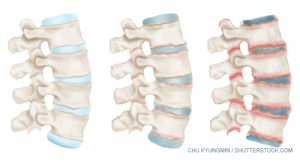
Normal and inflamed human vertebral
column joints in ankylosing spondylitis.
Sir William Osler, widely regarded as one of the greatest physicians of the 20th century, once said, “He who studies medicine without books sails an uncharted sea, but he who studies medicine without patients does not go to sea at all.”1 This sentiment is particularly true in the field of rheumatology, in which understanding the patient’s experience with their disease is perhaps even more important than rote memorization of the facts concerning the disease itself. This attitude and the need for objective measures of disease activity have led to the development of broadly accessible and easy-to-use patient-reported outcomes in many of the rheumatic diseases, including ankylosing spondylitis.
2 Important Self-Administered Instruments
In 1994, researchers in the United Kingdom published work describing two important self-administered instruments used to track the natural history and response to treatment in ankylosing spondylitis patients: The Bath Ankylosing Spondylitis Disease Activity Index (BASDAI) and the Bath Ankylosing Spondylitis Functional Index (BASFI).2,3 Both of these tools were developed using multidisciplinary teams of health professionals and by receiving direct input from patients with ankylosing spondylitis.
The BASDAI includes six visual analog scales used to measure the severity of fatigue, spinal and peripheral joint pain, localized tenderness and morning stiffness, both qualitatively and quantitatively, and the goal of this instrument is to measure disease activity, disease progression and prognosis in a reproducible and dependable manner.
Although this questionnaire measures symptoms of pain and stiffness, Andrei Calin, MD, FRCP, consultant rheumatologist at the Royal National Hospital for Rheumatic Diseases, Bath, U.K., and colleagues noted that what is not well captured by these questions alone is a patient’s level of function in daily life. Thus, the effort was made to develop a set of questions to examine the degree of difficulty a patient has performing activities related to functional anatomic limitations and to evaluate the patient’s ability to cope with everyday life, leading to the BASFI questionnaire (see Figure 1, below).
A Patient’s Perspective
Since these landmark publications, the BASDAI and BASFI have been used in many research studies and, increasingly, are employed in tracking disease status and progression by rheumatologists in the clinic. However, the question remains, how do patients feel about the use of such a functional index? To answer this question, we spoke with Gary Hitch, a senior noncommissioned officer in the U.S. Army who was diagnosed with ankylosing spondylitis 17 years ago.


